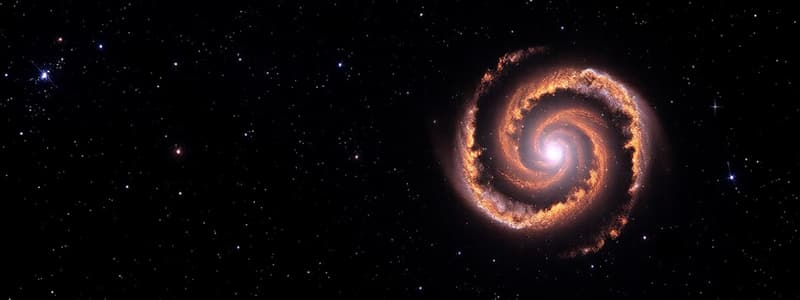Podcast
Questions and Answers
What role did volcanic eruptions play in the theory regarding past ice ages?
What role did volcanic eruptions play in the theory regarding past ice ages?
- They contributed to cooling the Earth by releasing gases trapping heat. (correct)
- They had no significant impact on past climate changes.
- They were believed to alter ocean currents that led to ice age formations.
- They increased global temperatures by releasing particulate matter.
Which gas was specifically mentioned as being released from volcanic eruptions that influences climate?
Which gas was specifically mentioned as being released from volcanic eruptions that influences climate?
- Carbon dioxide (correct)
- Sulfur dioxide
- Carbon monoxide
- Methane
What connection between human activity and climate change was established by the scientist's theory?
What connection between human activity and climate change was established by the scientist's theory?
- The release of greenhouse gases from human activity contributes to warming the Earth. (correct)
- Increased volcanic activity led to extreme global cooling.
- Human activity has negligible effects on the global climate.
- Human burning of fossil fuels reduced atmospheric carbon dioxide levels.
In what decade was the theory regarding the cause of past ice ages proposed?
In what decade was the theory regarding the cause of past ice ages proposed?
What was the primary effect of reducing gases like carbon dioxide as theorized by the scientist?
What was the primary effect of reducing gases like carbon dioxide as theorized by the scientist?
What year did Svante Arrhenius begin his studies in physics at the University of Uppsala?
What year did Svante Arrhenius begin his studies in physics at the University of Uppsala?
What profession did Svante Arrhenius hold after his studies?
What profession did Svante Arrhenius hold after his studies?
Which nationality did Svante Arrhenius identify with?
Which nationality did Svante Arrhenius identify with?
In what area did Svante Arrhenius establish his academic career?
In what area did Svante Arrhenius establish his academic career?
What was the full name of the university where Svante Arrhenius studied?
What was the full name of the university where Svante Arrhenius studied?
What major system did Annie Jump Cannon develop that laid the groundwork for stellar classification?
What major system did Annie Jump Cannon develop that laid the groundwork for stellar classification?
Which achievement is Henrietta Swan Leavitt famous for in the field of astronomy?
Which achievement is Henrietta Swan Leavitt famous for in the field of astronomy?
What significant discovery did Harriet Brooks make that transformed nuclear physics?
What significant discovery did Harriet Brooks make that transformed nuclear physics?
Srinivasa Ramanujan is best known for his contributions to which areas of mathematics?
Srinivasa Ramanujan is best known for his contributions to which areas of mathematics?
Erwin Schrödinger's wave equation greatly impacted the understanding of which phenomenon?
Erwin Schrödinger's wave equation greatly impacted the understanding of which phenomenon?
What key contribution did Ronald Fisher make to the field of genetics?
What key contribution did Ronald Fisher make to the field of genetics?
What was the main purpose of the experiment conducted by Harold Urey and Stanley Miller?
What was the main purpose of the experiment conducted by Harold Urey and Stanley Miller?
Which was a limitation of the work described regarding the scientists' contributions?
Which was a limitation of the work described regarding the scientists' contributions?
Flashcards are hidden until you start studying
Study Notes
Scientists and their Contribution to Climate Change
- A scientist at the University of Stockholm, in the 1890s, theorized that past ice ages might have been caused by fewer volcanic eruptions releasing gases, like carbon dioxide, into the atmosphere.
- These gases trap heat, and reducing them would cool the Earth significantly.
- This theory established a connection between human activity and rising global temperatures, laying the groundwork for modern climate change concerns.
Annie Jump Cannon (1863-1941)
- American astronomer who specialized in stellar spectra.
- Worked at the Harvard College Observatory for over 44 years.
- Classified over 350,000 stars using her 1901 system, a foundation for the Harvard Spectral Classification system.
Henrietta Swan Leavitt (1868-1921)
- Studied at Radcliffe College and the Harvard College Observatory.
- Observed a consistent pattern in the brightness of Cepheid variable stars, a crucial tool for measuring distances to other galaxies.
- Discovered more than 2,400 variable stars and four novae.
Harriet Brooks (1876-1933)
- First female nuclear physicist in Canada.
- Graduated from McGill University and studied under J.J. Thomson and Ernest Rutherford.
- Worked in Marie Curie's laboratory, discovering that one element can transform into another element through nuclear decay.
Srinivasa Ramanujan (1887-1920)
- Indian mathematician who made groundbreaking contributions to mathematical analysis and number theory.
- Had minimal formal training, but excelled in mathematics and sent theorems and ideas directly to G.H.Hardy in Cambridge, England
- Was awarded a Bachelor of Science degree in 1916 and was elected a Fellow of the Royal Society.
- Suffered from tuberculosis and returned to India, passing away in 1920.
Erwin Schrödinger (1887-1961)
- Austrian physicist who studied physics at the University of Vienna and the University of Zurich.
- Developed a groundbreaking wave equation that revolutionized the understanding of quantum physics.
- Proved that atomic electrons are "clouds" of probability rather than fixed orbits, changing our perception of atomic structure.
Ronald Fisher (1890-1962)
- British statistician and geneticist who pioneered the application of statistics to scientific experimentation.
- Reconciled the apparent inconsistencies between Charles Darwin's ideas on natural selection and Gregor Mendel's experiments on inheritance using statistical methods.
- Published a paper in 1918 outlining the use of statistical tools.
Harold Urey and Stanley Miller (1893-1981; 1930-2007)
- American chemists who recreated early Earth conditions in a laboratory to study the origin of life.
- Simulated early Earth environments with electrical sparks to mimic lightning.
- Experimentally produced important organic molecules (carbon-based compounds) from simple inorganic precursors (hydrogen, methane, and ammonia).
Svante Arrhenius (1859-1927)
- Studied physics at the University of Uppsala in Sweden.
- Became a professor of physics.
Studying That Suits You
Use AI to generate personalized quizzes and flashcards to suit your learning preferences.




